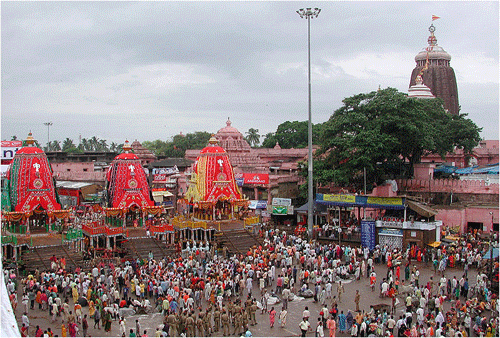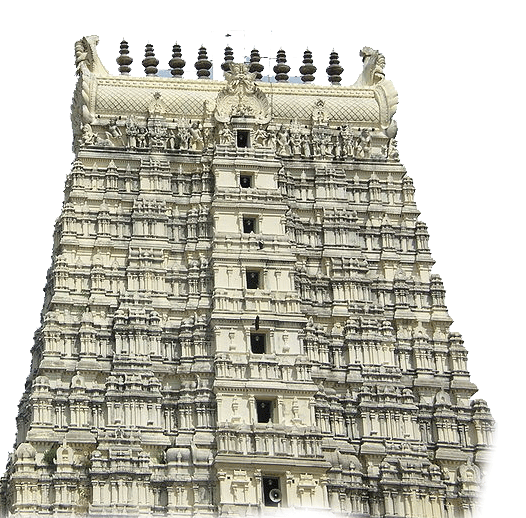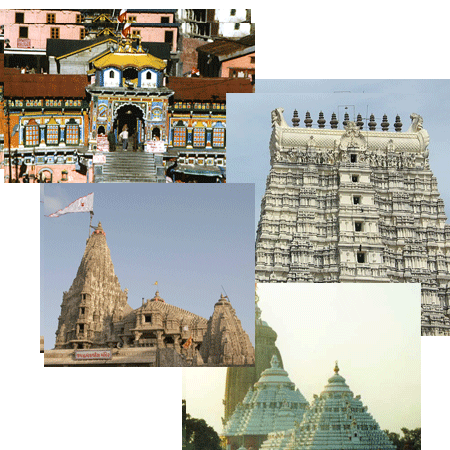Badrinath, Dwarka, Puri and Rameswaram
There are four revered pilgrim sites spread over the entire country, much revered, much loved and much visited by every Hindu. To visit them at least once in their lifetime is what every Hindu wishes.
Char Dham means, four abodes. The four abodes are Badriinath located in the state of Uttarakhand,Dwarka. in the west in the state of Gujrat,Jagannath Puri in the east in the state of Orissa and Rameswaram located in the Sothern state of Tamilnadu.
Though these four temples do not belong to the same sect, that is some are of Vaishnav sect and others are of Shaiva sect. But irrespective of this every Hindu longs to see these 4 pilgrimages at least once in life time.
Badrinath
Located in the Chamoli district in the state of Uttarakhnd, Badrinath is the most important of the 'Char Dham' temples.Badrinath which is in the Garhwal hills on the banks of the river Alaknanda river with an average elevation of 3, 415 meters. It's located 301 km north of Rishikesh. Vaishnavites regard Badrinath as a major pilgrim center
Bhagavata Purana mentions that the sages Nara and Narayana, incarnation of Vishnu were doing a massive penance at Badrkashram for the human welfare. According to a legend, Adi Sankara found Badrnarayan's image made of black stone in the river Alaknanda river.Adi Sankara installed the image of Badrinath in a cave near Tapt kund hot springs. The image was there until sixteenth century. The king of Garhwal moved the image to the present site.
Since then ,the temple suffered damages due natural calamities like avalanchies. Owing to the damages Badrinath temple has undergone several renovations.Inthe seventeenth century, the king of Garhwal has expanded the temple. But during the Himalayan earthquake in 1803,the temple of Badrinath was rebuilt by king of Jaipur.
The arcitecture of Badrinath temple resembles a Buddhist temple or a Vihara.Inside the temple there is a mandapa or a pillared hall filled with intricate carvings. This large pillared all leads to the main Garba Griha or the interior of the sanctum sanctorum.The Jains believe that the principal diety Badrinath as the first Tirthankar Rishabhnath.
Legends around Badrinath
Badrinth temple has a bevy of legends around it. All of them are interesting. Here are some legends.
In Hindu scriptures, Badrinath was referred as "Badari" or "Badarikashram". This place is a favourite place to Vishnu himself especially in the dual form of 'Nara' and 'Narayana.'Another legend says about the birth of river Alakananda. When Ganga was requested to descend on earth to save the suffering people,the earth was unable to stand the force of the mighty river Ganga. So Ganga was split into twelve channels. Alakananda was one of them.
The area of Badrinath is filled with the bushes of a fruit called Badri or'Ber' in hindi.. When lord Vishnu was meditating, Lakshmi stood by him and sheltered Vishnu from scorching heat of the Sun. and turned into a 'Badri' herself. In that form Lakshmi was called BADRI VISHAL and Vishnu, her lord became BADRI NATH.
In western Garhwal , there is a mountain called "Swargarohini", meaning ascending to heaven. This was the mountain peak used by Pandavas to go to heaven with an intention to end their lives. Legend has it that the Pandavas passed through Badrinath and the town of Mana, 4 km from Badrinath on their way to Swarga.
Dwarka
Dwarka derives its name from the Sanskrit word Dwar, means gate. Dwarka has several credits tucked under its belt. Besides beimg one of the Char Dtam along with Badrinath, Puri and Rameswaram, one of the 12 holy shrines of Siva, Nageswara Jyotirlinga is located near Dwarka. Out of the four Mathas established by Adi Sankaracharya,Dwarka Pitha is located in Dwarka. Sringeri,Puti and Jyotirmath are the other three Mathas.
Also known as Dwaravati is considered as one of the seven mos ancient cities in the country.This is the home place of Lord Krishna.The present temple was built in the sixteenth century CE. But the original temple was built by Krishna's great grandson king Vajra.Dwarka shrine is a architectural marvel of 5 stories built with lime and sand/.The entrance to the temple is known as Swarg Dvar and the exit is known as Moksh Dvar.From this temple the confluence of river Gomati with the sea can be seen.
The Dwarka mentioned in Mahabharata, Harivansha, Bhagavata Purana and Skanda Purana is said to be located near the present Dwarka city, whidh was submerged in to the sea.
The other important temples in Dwarka are
- Vasudeva
- Devaki
- Balarama
- Revati
- Jambavati
- Satyabhama
- Subhadra
- Rukmini
One can reach the temple of Bet Dwakka by boat. Bet Dwarka occupies an important place in the Hundu tradition. Its well known for its temples dedicated to Krishna. Its believed to have been submerged under the sea after Krishna left Dwarka for Vaiikuntha.
 Puri
Puri
Located in the East coast state of Orissa, now Odisha, Puri is placed 60 km south of the state capital Bhubaneswar. Puri is also known by the name Jagannath Puri.
Hindus believe, one's pilgrimage is not complete without a trip to Jagannath Puri.
Its very name conjures, even to a person who never visited Puri is the world famous 'Rath Yatra.'
This 11th century temple is also endowed with some of the beautiful beaches. Hence for its religious places and enchanting beaches, Puri has become one of the biggest tourist havens in the country.
A bevy of names
The holy ciity Puri has been referred with a number of names in the holy scriptures of Hinduism. Some of them are Srikshetra, Shankhkshetra,Neelachala, Neeladri, Purusottama Dhama,Purusottama kshetra and Purusottamapuri. "Puri" in Sanskrit means a city.
Uniqueness of Puri
it's the only temple, where along with Krishna, Radha, Lakshmi, Durga, Sati, Parvati and Shakti are enshrined.
There are four cardinal institutions or "Mathas" established by Adi Sankaracharya. Out of the four "Mathas". Govardhan Matha is one. And its where the holy place Puri is located.
Ratha Yatra, the festival of chariots
Who doesn't know about the renowned 'Ratha Yatra' of Puri?. Its this single festival that earns a lot of money through tourism to the state of Orissa. Ratha Yatra is the festival of carrying the deities, Jagannadh,Balabhadra and Subhadra on a chariot during the month of Ashada, rainy season on to the main street of Puri. From this spot all the deities are taken out in huge chariots to another temple called Gundicha Ghar.The deities are kept there for seven days. Again the deities are taken back to Shri Mandir. This return journey is known as 'Bahuda Yatra."
The Rathas or the chariots are made every year. That is the old chariots of previous years are not used. These huge chariots are pulled by the devotees all along the 3 km road from Jagannadh temple to Gundicha Ghar.
Chhera Pahara
Chhera Pahara is the ritual of sweeping and cleaning of the sacred Chariots and the way before the chariots of the deities start their journey to Gundicha Ghar with water by the Gajapati kings of Kalinga kingdom. This ritual is religiously followed through generations.
Rath Yatra is an international festival now
A.C Bhakti Vedanta Swami Prabhupada, ISKCN took initiative in making Ratha Yatra an international festival. Now Ratha Yatra is observed in more than 100 cities world over. Montreal. Paris, Newyork. Singapore. Torento are some of the places where Rath Yatra is observed on regular basis.
Rath Yatra in Bangladesh
Dhamraj, a place in Bangladeash observes Ratha yatra as "Dhamraj Jagannadh Roth" festival every year. Its an important event in among the Hindu community in Bangladesh. The original Roth was burnt by Pakistan army in 1971. Wth the assistance of India, the chariot was rebuilt.
Rath Yatra of Mahesh
Since 1397,Rath Yatra is being celebrated in Mahesh, Hoogly district of west Bengal. This chariot festrival is the oldest chariot festival after Puri. This Rath Yatra ls a week-long festival during which time, people in large numbers turn up to pulll the Jagannath Rath.
Rameswaram
One of the Char Dham pilgrimatges, Rameawaram is also one of the holiest places of India . Rameswaram is located in the Ramanathapuram district of Tamilnadu in south India.
Rameswaram in Savskrit means "Lord of Rama" or Siva, the presiding deity of the Ramanatha swamy temple
According to legend Sri Rama Chandra built a bridge well kmown as 'Rama Sertu' here to reach Lanka, where Ravana kept Rama Chandra's consort Sita after abducting her. Rameswaram is the closest point to reach Lanka, the kingdom of Ravana, the demon king.
Rama chandra, an incarnation of Vishnu, after the killing of Ravana, the demon king who abducted his consort, prayed Siva to pardon him if he had committed any sin inadvertently during the war.On the advice of the great sages, Rama along with Sita and brother Laxmana installed Sivalinga and worshipped Siva to wash off the sin of killng Ravana, a brahmin. In order to honour Siva, Rama wanted to install a large Sivalingam and osdered Hanuman to get one large Sivalingam from Himalayas. Though Hanuman left for Himalayas, it took more time to fetch the Sivalingam. But in the meantime, Sita made a small lingam and the puja was finished. The Lingam installed by Sita is what is there in Rameswaram today.
Ramanathaswamy temple
Its one of the 275 "Paadal Petra Sthalams." Paadal Petra Sthalams are the places praised and revered in the verses of Saiva Nayanars in the 6th to 9th century CE.
Nayanars are the Saivite saints. There are three most respected and erudite Saivite Saints. They are
- Appar
- Sundarar
- Tirugnana Sambandar
The above three Saivite saints gliorified the Ramanathaswamy temple in their immortal songs. This 12th century built temple was built by the kings of the Pandya dynasty.
The speciality of Ramanathaswamy temple is that, its equally respected by Shaivites, Vaishnavites and Smarthas. Ramanathaswamy temple is having the longest corridor among all the templed in India.
Other shrines in the temple
There are separate temples for Ramanathaswamy and Visalakshi, Santana Ganapathy,Maha Ganapathy, Subrahmanya. Mahalakshmi. Nataraja.Anjaneya to name a few. There are good number of Halls or Mandapms like Sukruvara Mandapam, Sethupathi Mandapam,Kalyana Mandapam and Nandi Mandapam.
Tanks or Tirthas and beliefs
There are 64 Tirthas in and around Rameswaram. Skanda Purana states Twenty four of the 64 Teerthas important, bathing in which is considered as holy and healthy. Ou t of the 24 Teerthas, 22 are inside the temple.
There is a sinificance for the numer 22. It signifies, 22 arrows in the quiver of Rama
Beliefs
Child-less couples bathing in this Teertham will be blessed with the children.
Bathing on New Moon days and full MOON DAYS will give a life of Happiness, prosperity and health.
Photos :WIKIMEDIA COMMONS
